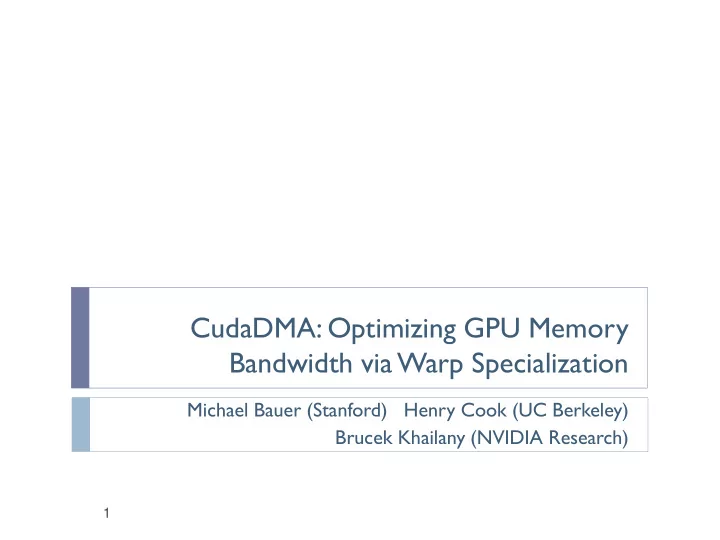

CudaDMA: Optimizing GPU Memory Bandwidth via Warp Specialization Michael Bauer (Stanford) Henry Cook (UC Berkeley) Brucek Khailany (NVIDIA Research) 1
GPUs Are Ubiquitous GPUs are in many supercomputers today GPUs are great High floating point performance High memory bandwidth Why is programming them so challenging? Explicit data movement through memory hierarchy Difficult to overlap computation and memory accesses 2
Outline Overview of GPU Architecture Motivating Benchmark CudaDMA API Methodology Experiments Conclusions 3
GPU Architecture/Programming SM SM SM SM CTA CTA CTA CTA Shared Memory Shared Memory Shared Memory Shared Memory On-Chip Memory Data Data Data Data Off-Chip DRAM 4
Warp Definition Each CTA is decomposed into warps A warp is 32 contiguous threads in the same CTA Warp 0 Warp 1 Warp 2 Warp 3 SM performs scheduling at warp-granularity Each warp has its own program counter All threads in a warp execute in lock-step Intra-warp divergence has performance penalty Inter-warp divergence has no performance penalty 5
Motivating Benchmark 6
Motivating Benchmark Modified SAXPY kernel, staging data through shared Variable amount of arithmetic Fixed amount of data transferred and number of warps Increasing compute 7 intensity
GPU Performance Challenges Memory System Bottlenecks Computational Bottlenecks Instruction Issue Long-latency memory accesses Memory Level Parallelism (MLP) Synchronization Data Access Patterns overheads Coalescing Data Access Patterns Control Divergence Goal: remove entanglement between the bottlenecks 8
GPU Programmability Challenges Mismatch CTA size/shape and shared data size/shape Leads to thread divergence (lots of ‘if’ statements) Goal: decouple CTA size/shape from data size/shape 9
Warp Specialization Differentiate warps into compute and DMA* DMA warps Maximize MLP Compute warps No stalls due to memory Producer-consumer synchronization Enable better overlapping of compute and memory accesses CudaDMA objects to manage warp specialization Describe data transfer patterns Independent of warp count 10 * D. Merrill and A. Grimshaw. Revisiting Sorting for GPGPU Stream Architectures.
CudaDMA API 11
CudaDMA API class cudaDMA Declare CudaDMA object { public: to manage shared buffer // Base constructor __device__ cudaDMA ( const int dmaID, const int num_dma_threads, Separate DMA and const int num_comp_threads, const int thread_idx_start); compute warps public: __device__ bool owns_this_thread(); public: // Compute thread sync functions Provide synchronization __device__ void start_async_dma(); __device__ void wait_for_dma_finish(); primitives public: // DMA thread sync functions __device__ void wait_for_dma_start(); __device__ void finish_async_dma(); public: Perform repeated transfer __device__ void execute_dma( operations void *src_ptr, void *dst_ptr); }; 12
CudaDMA Application Structure __global__ Declare shared buffer at void cuda_dma_kernel(float *data) { kernel scope __shared__ float buffer[NUM_ELMTS]; cudaDMA dma_ld(0,NUM_DMA_THRS, Declare CudaDMA NUM_COMPUTE_THRS, NUM_COMPUTE_THRS); object to manage buffer if (dma_ld.owns_this_thread()) { // DMA warps Split DMA warps from for (int i=0; i<NUM_ITERS; i++) { dma_ld.wait_for_dma_start(); compute warps dma_ld.execute_dma(data,buffer); dma_ld.finish_async_dma(); Load buffer using DMA } } warps else { // Compute warps for (int i=0; i<NUM_ITERS; i++) { Process buffer using dma_ld.start_async_dma(); dma_ld.wait_for_dma_finish(); compute warps process_buffer(buffer); } Iterate (optional) } } 13
Execution Model Use PTX named barriers bar.sync Compute DMA Warps Warps bar.arrive start_async_dma wait_for_dma_start Available on Fermi bar.arrive bar.sync Named Barrier 1 wait_for_dma_finish finish_async_dma Fine-grained bar.sync bar.arrive Named synchronization Iteration i Barrier 2 Named Barrier 1 Named Barrier 2 Iteration i+1 14
CudaDMA Methodology 15
Buffering T echniques Usually one set of DMA warps per buffer Single-Buffering One buffer, one warp group Double-Buffering Two buffers, two warp groups Manual Double-Buffering Two buffers, one warp group 16
CudaDMA Instances CudaDMASequential CudaDMAStrided CudaDMAIndirect Arbitrary accesses CudaDMAHalo 2D halo regions CudaDMACustom 17
Access Patterns Explicitly state data loading pattern in code Decouple implementation from transfer pattern Common patterns implemented by experts Used by application programmers Optimized for high memory bandwidth at low warp count 18
Experiments 19
Micro-Benchmarks Same modified SAXPY kernel shown earlier Fix compute intensity (6 B/FLOP), vary warp count 20
BLAS2: SGEMV Dense matrix-vector multiplication CudaDMASequential for loading vector elements CudaDMAStrided for loading matrix elements Varied buffering schemes Up to 3.2x speedup 21
3D Finite Difference Stencil 8 th order in space, 1 st order in time computation Load 2D slices into shared for each step in Z-dimension Loading halo cells uses uncoalesced accesses Earlier version of cudaDMAHalo 22 Figures from: P. Micikevicius. 3D Finite Difference Computation on GPUs Using CUDA.
3D Finite-Difference Stencil Use DMA warps for loading halo 35 33.14 cells as well as 29.1 30 27.83 main block cells 25.22 24.16 25 22.3 20 Speedups from 13-15% 15 Execution Time (s) 10 Improvement 5 from more MLP 0 512x512x512 640x640x400 800x800x200 and fewer load Reference CudaDMA instructions Problem Size 23
Conclusions CudaDMA Extensible API Create specialized DMA Warps Works best for moderate compute intensity applications Decouple transfer pattern from implementation Optimized instances for common patterns CudaDMASequential, CudaDMAStrided CudaDMAIndirect, CudaDMAHalo Speedups on micro-benchmarks and applications 24
Download CudaDMA: http://code.google.com/p/cudadma Tech Talk at NVIDIA Booth on Thursday at 1pm Questions? 25
Backup Slides 26
Asynchronous DMA Engines Decouple transfer implementation from specification Asynchronous to overlap computation and memory access Ironman abstraction for ZPL (software) Sequoia runtime interface (software) Cell Broadband Engine (hardware) Imagine Stream Processor (hardware) 27
Code Example: SGEMV BLAS2: matrix-vector multiplication Two Instances of CudaDMA objects Compute Warps Vector DMA Warps Matrix DMA Warps 28
Synchronization Points Compute Warps start_async_dma() wait_for_dma_finish() DMA Warps wait_for_dma_start() finish_async_dma() 29
Future Work Additional CudaDMA Instances Indirect memory accesses More applications Sparse-Matrix operations Target for higher-level language/DSL compilers Copperhead, Liszt Actual hardware DMA engines for GPUs Warp-specialization aware programming models Compiler implementations 30
Fast Fourier Transforms 1D, Power of 2 FFTs Compared to optimized CUFFT library (version 4.0) 32 warps per SM CudaDMA (custom loader) 24 warps per SM 16 compute, 8 DMA Same performance at lower warp count 31
Recommend
More recommend